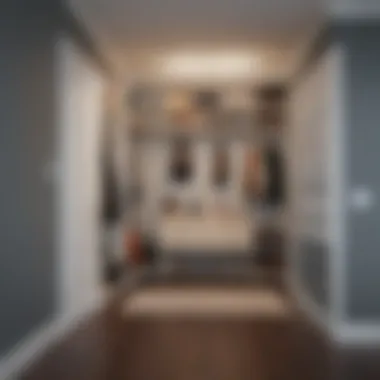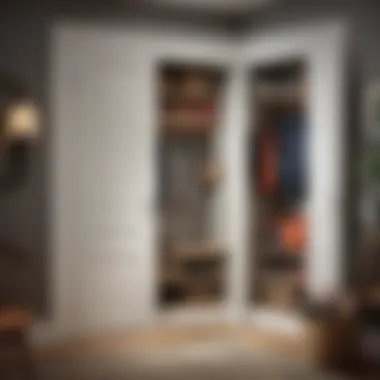Effective Strategies for Organizing Your Entryway Closet


Intro
When considering the flow and functionality of your home, the entryway closet often doesn’t get the attention it truly deserves. This small yet impactful space can set the tone for your entire home. It greets you and your guests, and its organization can either facilitate ease or create chaos. Space mismanagement can turn your entryway into a clutter zone, making daily routines cumbersome. But with thoughtful strategies, you can transform that area into an organized haven that blends style with practical usability.
In this article, we will explore ways to optimize your entryway closet, diving into selecting the right storage solutions, categorizing the various types of items you have, and maintaining a neat space. We’ll also touch on some aesthetic considerations that make organization not just achievable but also visually pleasing.
Interior Design Tips
An organized and stylish entryway closet can enhance the ambiance of your home. Here are some design tips that can help you get started:
Trendy Design Ideas
Think about utilizing modern designs that cater to your personal taste while focusing on functionality. For instance, adding open shelving can not only display beloved items but also create a minimalist feel, avoiding the crowded look that often plagues closed storage systems.
Additionally, consider incorporating hooks or wall-mounted cubbies. They offer convenient access to essential items, like bags or umbrellas, inviting an atmosphere of welcoming order.
Color Schemes and Combinations
Choosing a color palette is crucial in making your entryway closet feel cohesive. Soft neutrals like greys or creams can make the space appear larger, while accents of brighter colors through decor or storage bins can add a personal touch. You may choose colors that mirror your homes's overall theme for a seamless blend.
Furniture Arrangement Techniques
Optimizing the layout is imperative for functionality. If space allows, a bench can double as storage—it can provide a place to sit while putting on shoes and hold items like gloves or scarves underneath. Ensure that everything is within arm's reach and looks tidy, enhancing not just practicality, but also inviting a pleasing aesthetic for arrivals and departures.
"An entryway should be not just functional, but also a reflection of you and your family’s lifestyle."
Selection Criteria for Storage Solutions
Finding the right storage can be a challenge, but it is essential. Here are some criteria you might consider:
- Space efficiency: Ensure that the storage you choose fits well within your closet dimensions without cramping the space.
- Versatility: Look for solutions that can serve multiple purposes. Baskets can store a range of items while looking chic.
- Durability: Invest in materials that will stand the test of time, especially if the space is heavily used.
Categorization of Items
Next comes the actual sorting of items. A straightforward approach involves:
- Seasonal Sorting: Store off-season items like heavy coats in bins or high shelves, while keeping daily essentials easily accessible.
- Type-Sorting: Group similar items together. For instance, hats and scarves can be organized in corresponding bins, ensuring a quick grab when on the go.
- Accessibility: Place items you reach for most at eye level; it will save time and keep things looking tidy.
Maintenance Strategies
Keeping your entryway closet organized isn't a one-off task. It's crucial to adopt maintenance strategies:
- Regular Checks: Schedule a monthly review to remove any items that no longer belong or that have not been used in a while.
- Daily Habits: Encourage family members to return items to their designated spaces post-use, this prevents clutter from accumulating.
- Label Everything: This simple technique is effective for ensuring everyone knows where things belong, thus maintaining order effortlessly.
Understanding the Importance of an Organized Entryway Closet
An entryway closet isn’t just a place to stash coats, shoes, and bags; it is pivotal in setting the tone for your entire home. When guests step through your door, it only takes a glance to form an impression. An organized entryway closet speaks volumes about the care and consideration you dedicate to your living space.
First Impressions Matter
Picture this: you stroll into someone’s home and are immediately greeted by cluttered jackets and mismatched shoes piled high. It doesn’t exactly say "welcome". In fact, it’s a strikingly clear message that perhaps order is not a priority in that home. On the flip side, a tidy and well-structured entryway closet can exude warmth and hospitality. Organizing that space can transform not only the first impressions of guests but can also evoke a sense of pride and comfort for those who live there.
- Clutter-free Entry: A neat entryway allows you to breathe easy. It creates a serene beginning and sets a positive mood from the get-go.
- Functional Flow: It paves the way for a smoother transition into your home. You can easily find what you need without fumbling through piles, which can also save time.
Functional and Aesthetic Balance
Finding a middle ground between practicality and aesthetic appeal is essential. An entryway closet that’s merely functional but visually unappealing limits the role it can play in your home’s decor.
A well-thought-out closet combines both function and style, making your space easier to navigate while also looking good. After all, your entryway is a reflection of your style and habits.
- Purposeful Design: When your closet is organized, every item has its place. This makes it easier to maintain order.
- Visual Harmony: Incorporating color schemes and materials that match your home enhances the aesthetics of an entryway. It tells a cohesive story about your home even before guests step inside.
Creating that balance can sometimes feel like walking a tightrope, especially with varying needs and personal tastes. However, when you take the time to assess your entryway closet systematically, you can achieve an inviting space that is equally functional.
"An entrance sets the tone of the entire home, laying the groundwork for the experiences shared within its walls."
Investing effort into organizing this often-overlooked area results in more than just convenience; it leads to enriched living, elevating your daily routine while impressing those who cross your threshold.


Assessing Your Current Closet Situation
Before diving into the logistics of organizing your entryway closet, it’s essential to take a step back and assess your current situation. Understanding what you have and how it’s being used provides a clear baseline that guides your strategy for improvement.
Inventory of Existing Items
One of the first steps in this assessment is conducting an inventory of the items currently stashed away in your closet. This helps you realize the sheer volume of your possessions, which may have become a bit of a blind spot over time. Grab a notepad or use your phone to jot down every item; take a close look at shoes, coats, bags, and any seasonal accessories.
Categorizing these items as you go can be beneficial. Consider grouping them into three main categories:
- Frequently Used: Items you wear often, such as daily shoes or jackets.
- Occasional: These include seasonal clothing or items you wear only at certain times of the year, like winter coats.
- Rarely Seen: Bust out those hidden treasures that rarely see the light of day. If you've got things in there you forgot you even owned, it's time to fathom whether you need to keep or let go.
This inventory will not only highlight what you have but also expose gaps in your organization and perhaps reveal duplicates you didn’t even realize were lurking in that jumble of coats and umbrellas.
Identifying Underutilized Space
Now that you’ve got a clear picture of the items in your closet, it’s time to inspect the space itself. An entryway closet often harbors more potential than meets the eye. Lean into that!
Take a good look at the vertical space available. Is there room for a shelf above your current storage solutions? Hooks that dangle down low could also be switched for higher ones, allowing for taller items or bins below. Consider these points:
- Vertical vs. Horizontal Space: Many folks focus on how wide their closet is but overlook how tall it can be. Utilize that verticality to your advantage!
- Nooks and Crannies: Pay particular attention to corners or spaces behind doors. These often neglected areas can be transformed into clever storage zones.
"A well-organized space isn’t just functional; it invites ease and grace into daily routines."
Evaluating Your Lifestyle Needs
To wrap up this chain of assessments, think deeply about your lifestyle. Different households have different needs, and understanding yours can significantly influence your organizational decisions.
- Family Members' Habits: If you have kids who throw their shoes everywhere, perhaps a shoe rack that’s accessible for little hands should top the list.
- Personal Routines: Do you rush out the door daily or have leisurely weekends? Tailor the space according to your routines—place daily essentials at the forefront and tuck away the less frequently used items.
Reflecting on these points allows you to fine-tune your space. This way, you can design an entryway closet that supports your daily life rather than hindering it. It’s all about crafting a functional space that resonates with your unique lifestyle, making every entry and exit a tad more pleasant.
Designing Your Ideal Entryway Closet
Creating an entryway closet that reflects your personal style while also being functional is a blend of art and practicality. The design phase is where you envision what your space could transform into, considering the various elements that can impact functionality, storage efficiency, and aesthetic appeal.
When you think about how often the entryway is the first touchpoint for anyone stepping into your home, it’s crucial to create a space that feels welcoming yet organized. A well-designed closet can streamline your daily routines, making it seamless for everyone to grab what they need and head out the door.
Choosing the Right Storage Solutions
Choosing the right storage solutions is at the core of designing your ideal entryway closet. Depending on your preferences and the overall space available, each option offers its own set of benefits. Let’s delve into the choices that can really set your closet apart.
Open Shelving vs. Closed Cabinets
Open shelving and closed cabinets represent two distinct philosophies in storage design. Open shelving promotes visibility, providing easy access to items like shoes and bags without the need to rummage through drawers. One of the key characteristics of open shelving is its inclination towards a minimalist aesthetic. It often encourages thoughtful organization, as items displayed must maintain a certain order.
On the other hand, closed cabinets shield items from dust and clutter visibility. Their unique feature lies in their ability to conceal chaos behind closed doors. Many homeowners favor closed cabinets to maintain a sleek and tidy look, especially in a space that also serves as a walkway.
In the context of entryway organization, it's useful to consider the advantages and disadvantages:
- Open Shelving:
- Closed Cabinets:
- Advantages: Easy access to items, encourages organization, adds a modern touch.
- Disadvantages: Can become cluttered, requires regular upkeep to maintain aesthetic.
- Advantages: Hides clutter, protects items from dust, can be more visually appealing in some designs.
- Disadvantages: Items can be less visible, leading to potential forgotten items.
Hooks, Racks, and Baskets
Hooks, racks, and baskets serve as versatile solutions for entryway organization. They help maximize vertical space and are a practical choice for everything from coats to bags and even keys. Hooks are particularly useful because they allow quick access to frequently used items while keeping them off the floor. Racks, especially multi-tiered options, can hold shoes or other accessories neatly in place.
The main characteristic lies in their combination of form and function. Baskets can add texture and warmth to your closet while serving great organizational purposes. They can group similar items together, which is a handy way to keep things neat.
The pros and cons of this approach include:


- Hooks:
- Racks and Baskets:
- Advantages: Easy to install, quick access, stylish if chosen carefully.
- Disadvantages: Can lead to clutter if overused.
- Advantages: Keep items contained, enhance organization, versatile in style and size.
- Disadvantages: Can take up space if not sized correctly.
Space-Saving Techniques
In the quest for a neat entryway closet, space-saving techniques become crucial. These can involve using shelves that can adjust to different heights, incorporating sliding doors, or using behind-door storage solutions. The magic of space-saving techniques is all about maximizing what’s available without pushing the design into disarray.
One key characteristic is their ability to fit even in tight spots, making them indispensable for smaller homes or apartments. For instance, a shoe rack fitted to tuck into a corner or a narrow space can help in efficiently organizing footwear without hogging space.
Here are some advantages and disadvantages of these techniques:
- Advantages: Saves space, promotes effective use of vertical and horizontal areas, clever designs can add flair.
- Disadvantages: May require more planning initially, can be pricey depending on what you design.
Color Schemes and Materials
The materials and color schemes you choose play an essential role in the design of your closet. Color can evoke certain feelings, while material choices affect the durability and maintenance. Combining inviting colors with solid materials can create a cohesive look that aligns with your personal taste. It’s important to think about how these choices reflect your style and how they integrate with the rest of your home.
A limited palette, or using natural materials such as wood alongside soft, appealing colors, can enrich your entryway space while ensuring it’s functional. Balance is key, as you want your space to feel both serene and practical.
With a little foresight and creativity, designing your ideal entryway closet can become a rewarding project that enhances not just your storage capabilities but your overall home style as well.
Implementing Organizational Strategies
Organizing an entryway closet calls for strategic planning and thoughtfulness. By putting effective organizational strategies into play, homeowners can transform a chaotic storage area into a harmonious blend of functionality and style. The specific elements of categorization, labeling, and zoning not only streamline everyday use but also create a space that is a reflection of personal taste.
Emphasizing these strategies helps in maximizing the utility of every inch in the closet, making retrieval and storage a breeze. This methodical approach can lead to faster mornings and less stress, ultimately enhancing the overall ambiance of your home.
Categorization of Items
Seasonal Items
When dealing with seasonal items, it’s important to recognize their role in managing your closet's rotation. Not only do they tend to take up significant space, but understanding their key characteristic is crucial: they change with the seasons! By designating a specific area within your closet for items like coats, hats, or summer gear, you can maintain clearer visibility and access.
The unique feature of seasonal items is that they are often bulky. Hence, leveraging bins or boxes to neatly store these articles prevents clutter. However, they can pose a challenge in terms of organization because of their sporadic use throughout the year. Planning ahead by swapping out items as seasons change ensures a smoother transition without overwhelming the space.
Daily Essentials
Daily essentials represent the lifeblood of any entryway closet. Think of those items you reach for without even thinking: keys, umbrellas, and bags. The key characteristic of daily essentials is their frequency of use, making them a top priority in the organization game. Having a designated space for these items can not only save time but also helps in keeping the entryway tidy.
Since daily essentials are used regularly, a unique feature worth noting is their versatility. Items such as hooks and small trays can serve to keep these essentials front and center. The downside? If they aren’t properly assigned, these frequently used items can become sources of clutter. It’s imperative to ensure a clean and defined spot for them.
Occasional Use Items
Occasional use items are those pesky things that you don’t need every day, but you'd miss them if they weren't available. These include items like holiday decorations, hiking gear, or replicable storage bins. Their important contribution lies in their ability to support unique activities without taking over your entire closet.
The key trait of occasional use items is their temporary nature; they often reside in the closet when not needed. While they can sometimes create a fresh dilemma of space, using clear bins labeled with contents can make these items easy to retrieve. The drawback? Being too many in number can lead to confusion if not handled correctly. A thoughtful approach to organizing is essential to keep your entryway functional.
Effective Labeling Techniques
Once categorization is complete, the next logical step is effective labeling. A well-labeled closet is akin to a well-planned map; it guides your actions, reducing the time spent searching for items. Simple techniques like writing labels can enhance the organization greatly.
You could use color-coded labels to visually distinguish between different categories or stick to clear, concise wording for easy readability. Laminating labels adds durability, especially if they endure heavy usage. Many homeowners find it helpful to attach the specific category's name and an example of items contained within. Showing pictures can be particularly beneficial if others share the space.
Creating Zones Within the Closet
Crafting zones within the closet is crucial for ensuring that everything has its rightful place. By dividing the space into sections—perhaps one for shoes, another for coats, and another for accessories—you allow for efficient use of the suite. This simple partitioning aids in finding items quickly and even encourages keeping the area organized.
When creating zones, consider the size and shape of the items being stored. Tiers for footgear or specialized hooks for bags can make daily routines simpler. Furthermore, visual barriers like small baskets could help maintain goodies by genre, such as sports gear or electronic accessories.
Ultimately, these strategic implementations of organization make a world of difference, transforming a simple entryway closet into a well-functioning and aesthetically pleasing environment.


Maintaining Organization Over Time
Keeping your entryway closet organized isn't just a one-and-done situation. It requires ongoing attention to ensure the space remains functional and aesthetically pleasing. The benefits of this approach are twofold: it enhances the daily efficiency of your home life and fosters a welcoming atmosphere for guest and family alike. By embracing regular maintenance, you’re investing in the harmony of your entryway, preventing clutter from sneaking back in, and making it a true reflection of your personal style.
Regular Review and Purging
The heart of maintaining an organized entryway closet is establishing a routine for review and purging of items. Every few months, take a moment to assess what you store. Ask yourself questions like, "When was the last time I used this?" or "Does this serve a purpose anymore?" This thoughtful evaluation strips down your belongings to only the essentials.
Consider adopting a one in, one out rule. For instance, if you buy a new pair of shoes, make sure to donate or discard an old pair. Keeping a tight ship prevents new acquisitions from overwhelming your closet. Plus, when you regularly take stock, things do not accumulate. Be ruthless, but also consider the sentimental value of items; sometimes a keepsake does have a place in your life.
Adapting to Changes in Lifestyle
Life changes and so do our needs. Perhaps you've moved to a new home, had children, or even taken up new hobbies. Each of these transitions may necessitate adjustments in your entryway closet. If you’re a family with kids, your storage strategy will likely lean towards accommodating various sizes of shoes and outerwear, which may not been the case before children entered the picture.
Stay flexible. Regularly revisiting your organizational methods allows your closet to grow and shift with you. Also, make it a point to rotate seasonal items. When that first chill of autumn hits, swap out summer sandals for cozy boots. This not only keeps the closet neat but gives you the freshest options at your fingertips.
"Life is what happens when you're busy making other plans."
– John Lennon
Involving Family Members
An organized closet isn’t just a solo endeavor; consider involving family members in the upkeep of the entryway closet. Delegate specific items for each family member to be responsible for. When children can decide where their shoes go, they’re more likely to put them back in the right spot. This empowerment fosters responsibility and creates a communal sense of ownership over the space.
Having family meetings to discuss what works and what doesn't can also be helpful. Open a dialogue about the importance of keeping the entryway tidy and the role it plays in daily life. It emphasizes cooperation and builds a teamwork vibe in the household.
Regular upkeep, adaptability to life's changes, and engaging your family are pivotal in ensuring your entryway closet remains an emblem of organization. In doing so, you cultivate a space that is not just functional but also a reflection of your style and values.
The Role of Personal Touch in Closet Design
When setting about to organize an entryway closet, one tends to think about mere functionality: out of sight, out of mind, so to speak. However, the role of personal touch in closet design takes it a step further. It transcends basic organization, nurturing a sense of belonging and comfort. Crafting a space that resonates with your personality instills a welcoming ambiance from the moment someone walks through the front door. It becomes less of a cluttered storage area and more a reflection of who you are.
Incorporating Personal Artifacts
Incorporating personal artifacts into your entryway closet can breathe life into an otherwise mundane space. Think of family heirlooms, travel souvenirs, or even artworks that you cherish. These objects serve not only as decorations but also as conversation starters and keep memories alive.
When considering what to add, reflect on items that hold significance; something like a woven basket from your trip to Mexico can evoke memories or initiate conversations about your journey. Just as you might choose to display photos of loved ones on your walls, your closet’s contents can similarly echo your life’s narrative.
However, it’s vital to strike a balance. Too many personal artifacts might turn the closet into a chaotic exhibition rather than a rejuvenating space. Here are a few tips to consider:
- Showcase a Selection: Choose a few standout pieces rather than cluttering with numerous smaller items.
- Rotate Periodically: Swap out artifacts to keep your space feeling fresh through the seasons.
- Use Functional Decor: Select items that also serve a purpose, like decorative bins or stylish umbrellas that enhance both form and function.
Reflecting Personal Style
Reflecting personal style through your entryway closet matters in creating an inviting atmosphere. Your entryway is the first impression visitors get of your home, and the closet plays a crucial role in that.
Carefully consider color palettes, materials, and even the arrangement within the closet. A minimalist approach with neutral colors can impart elegance and calmness, while vibrant hues might convey warmth and excitement. For instance, if you're drawn to bohemian style, think about using natural materials like wicker with eye-catching patterns.
In terms of functionality, ensure that the closet aligns with your day-to-day needs while embodying your aesthetic preferences.
For example, if you often use certain items, position them at eye level while reserving higher shelves for less frequently used things. This can be a practical way of ensuring ease while respecting your individual tastes and inclinations.
"Your home should be a reflection of who you are, and the entryway is the first chapter of that story."
Remember, style doesn’t just stop with aesthetics—consider adding scents or gentle lighting to enhance the experience. Integrating elements such as essential oil diffusers or the soft glow of LED lights can elevate the ambiance and provide a even more personal touch.
In summary, the personal touches in your entryway closet transform it from a mere storage area into a true manifestation of character. When thoughtfully curated, artifacts and design choices convey a story, engage guests, and ultimately foster a sense of belonging—a welcoming embrace from the moment you enter your home.
End: The Value of an Organized Entryway Closet
An organized entryway closet isn't just a place to shove shoes and bags; it's a gateway that reflects your lifestyle and personality. The value of maintaining this space goes beyond aesthetic appeal. It plays a pivotal role in the daily rhythm of your home, serving both functional and emotional needs.
First, an organized closet leads to a smoother start each day. Imagine heading out for work or an outing, and instead of rifling through a clutter of coats, shoes, and bags, you find everything in its place. This clarity saves precious minutes every morning, reducing stress and setting a positive tone for your day ahead. With specific zones for seasonal items, daily necessities, and even the occasional use items, you can quickly grab what you need and head out.
Moreover, the design of your entryway closet can significantly impact the overall ambiance of your home. Entryways often serve as the first impression for visitors. A well-organized closet projects a sense of order and thoughtfulness, hinting that you care about your space.
In addition, the organization allows you to incorporate personal touches. By introducing unique artifacts or stylistic choices that reflect your personality, your entryway closet transforms from a mundane storage space into a storytelling canvas. This creates a welcoming atmosphere that resonates with anyone who crosses your threshold.
"An entryway should not just be functional; it should tell a story about you, your life, and what you cherish."
Lastly, it’s crucial to think about the sustainability of your organizational efforts. The strategies you implement to keep your closet tidy must adapt as your life evolves. A growing family, changing hobbies, or even seasonal shifts in items require ongoing attention. Regularly reassessing your needs and purging items that no longer serve you is essential. This way, your closet remains a true reflection of your current lifestyle, making it easier to maintain its organization over time.
In sum, an organized entryway closet enhances functionality, enriches personal style, and creates lasting first impressions—all of which contribute to the harmony of your home. By investing time and effort into this space, you pave the way for a more organized and pleasant living environment. \nThis small corner of your home can indeed hold great value.







